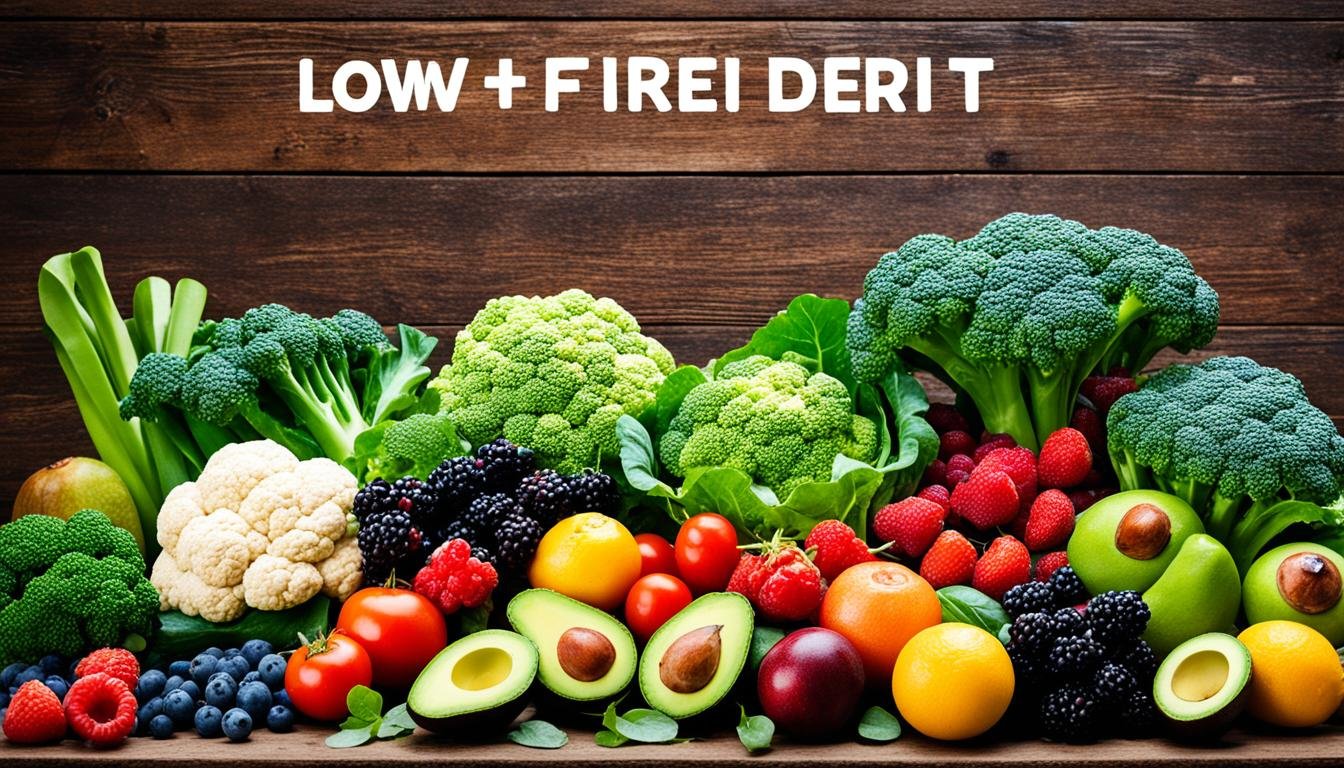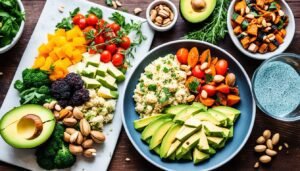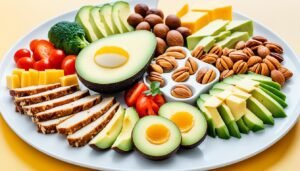The ketogenic diet is surging in popularity for its weight loss and health perks. When diving into this diet, it’s key to keep your fiber levels up. Doing so supports your gut and wellness. We will detail why fiber is vital, share top fiber-rich foods, and how to add them to your diet.
Key Takeaways
- Keto diets can lead to common digestive issues like constipation and heartburn if fiber intake is inadequate.
- High-fiber foods like avocado, chia seeds, and broccoli can be valuable additions to a keto diet.
- Consuming enough fiber can help manage blood sugar levels and promote feelings of fullness on a low-carb diet.
- Exploring fiber-rich keto-friendly options and using supplements like psyllium husk can help bridge the fiber gap.
- Proper hydration is crucial when increasing fiber intake on a keto diet.
What is a Ketogenic Diet?
The ketogenic diet is a way of eating that’s high in fat and low in carbs. It aims to put your body in a state called ketosis. In ketosis, your body uses fat and ketones for energy instead of glucose. This change may help with losing weight and controlling blood sugar.
Understanding the Basics of Keto
For the ketogenic diet to work, you need to eat the right amounts of macronutrients. The usual ratios are:
- Carbs: 5-10%
- Fats: 70-75%
- Protein: 15-20%
These numbers help your body burn fat and ketones rather than carbs for energy. By eating few carbs, your body enters ketosis. This might bring several health benefits.
Macronutrient Ratios in a Keto Diet
Success on the keto diet means sticking to the right macros. You should aim for a very low carb, high fat, and moderate protein diet. This translates to only 5-10% of your daily calories from carbs, 70-75% from fats, and 15-20% from proteins. These ratios help your body switch to using fat for energy, instead of carbs.
On the keto diet, you’ll eat foods rich in fats and low in carbs. This includes meat, fish, eggs, dairy, nuts, seeds, and specific vegetables. Choosing from this list lets you prepare meals that are good for your health and can help with managing your weight.
Benefits of Fiber on a Keto Diet
The keto diet can help with weight loss and controlling blood sugar. But, if you don’t get enough fiber, it may cause stomach problems. Fiber is important for keeping your stomach healthy and making you feel full on a keto diet.
Eating enough fiber also stops common keto problems like being constipated or feeling bloated. Plus, it might lower the chances of getting heartburn.
Promoting Regularity and Digestive Health
The keto diet, with its focus on low carbs and high fat, can cause constipation. But, fiber can help. It makes sure your bowels move regularly and keeps your stomach healthy. Fiber benefits on keto means you’re less likely to have constipation or other stomach problems on a keto constipation or keto digestive issues diet.
Feeling Fuller and Satisfied
Fiber is key for making you feel full on the keto diet. It takes a long time to digest, which means you don’t feel hungry as quickly. This is good news for anyone trying to deal with keto constipation or just wanting to eat less. Adding fiber can help control your hunger, making it easier to stay on a low-carb diet.
| Fiber Source | Fiber Content (per 100g) | Net Carbs (per 100g) |
|---|---|---|
| Avocado | 7g | 2g |
| Chia Seeds | 34g | 8g |
| Flax Seeds | 27g | 2g |
| Psyllium Husk | 78g | 11g |
| Acacia Fiber | 5g | 0g |
As the table shows, there are lots of fiber benefits on keto. They’re good for your stomach and help you feel full on a low-carb diet. Adding fiber from food or supplements can solve keto constipation and other keto digestive issues. It also boosts your health and well-being overall.
keto diet fiber
Fiber is very important on a ketogenic diet. It helps keep you healthy and fits the low-carb way of life well. There are two main types of fiber: soluble and insoluble. Each has its own benefits for those on keto.
Soluble vs. Insoluble Fiber
Soluble fiber mixes with water and can aid in controlling blood sugar and cholesterol levels. Foods that are Soluble fiber keto friendly include avocados and chia seeds. Broccoli and Brussels sprouts are also good sources. Insoluble fiber keto doesn’t mix with water. It helps keep your digestion regular by adding bulk to your waste. Eating leafy greens, nuts, and seeds is a good way to get insoluble fiber on keto.
It’s crucial to have both soluble and insoluble fiber on a keto diet. Fiber slows down how quickly you absorb nutrients. This helps you feel full longer. It also keeps your energy levels steady, even with fewer carbs.
Net Carbs in Fiber-Rich Foods
Tracking your net carbs fiber is important on keto. When doing this, subtract the fiber content from the total carbs. Since fiber affects blood sugar differently, you don’t count it in your net carbs.
Let’s take an avocado as an example. It has 12 total carbs, but 10 grams of those are fiber. This means you only count 2 grams of net carbs. Avocados are a great choice for a high-fiber, low-carb meal or snack.
Low-Carb, High-Fiber Food Options
On a keto diet, it’s key to find foods low in carbs but high in fiber. This is crucial for good digestion and staying in ketosis. Luckily, there are many tasty, nutritious foods that fit the bill.
Here are some great options to consider:
- Leafy Greens: Spinach, kale, and Swiss chard are fiber-rich and low in carbs, perfect for keto diets.
- Avocados: A small avocado has 9 grams of fiber and just 3 grams of net carbs, ideal for keto meals.
- Nuts and Seeds: Almonds and flax seeds are great for fiber and crunch, fitting well into a keto plan.
- Cruciferous Vegetables: Vegetables like broccoli and cauliflower are both low-carb and high-fiber.
- Keto-Friendly Pastas and Rice: Konjac root options, such as shirataki noodles, offer fiber with few net carbs.
Eating these foods on a keto diet can improve your digestion and keep you feeling satisfied. They support staying in ketosis. Choosing these types of foods helps you get the fiber you need while keeping carbs low.
| Food | Fiber (grams) | Net Carbs (grams) |
|---|---|---|
| Flax Seeds (2 tbsp) | 4 | 0 |
| Chia Seeds (2 tbsp) | 11 | 2 |
| Avocado (1 small) | 9 | 3 |
| Almonds (1 oz) | 4 | 3 |
| Unsweetened Coconut Meat (1 oz) | 5 | 2 |
| Blackberries (1 cup) | 7 | 6 |
| Raspberries (1 cup) | 9 | 8 |
| Pistachios (1 oz) | 3 | 5 |
| Wheat Bran (1/4 cup) | 6 | 4 |
| Cauliflower (1 cup chopped) | 2 | 2 |
Eating these foods on a keto diet can improve your digestion and keep you feeling satisfied. They support staying in ketosis. Choosing these types of foods helps you get the fiber you need while keeping carbs low.
Incorporating Fiber-Rich Vegetables
On a keto diet, choosing the right keto high fiber vegetables is key. It helps keep your gut healthy and lets you get important nutrients. Leafy greens and cruciferous vegetables are great for this eating style.
Leafy Greens and Cruciferous Veggies
Kale, spinach, and arugula are filled with fiber and nutrients. They are top picks for leafy greens on keto. Cruciferous vegetables like broccoli, cauliflower, and brussels sprouts also add needed fiber. Mix them in your meals, like in salads or smoothies, to up your fiber game.
Consider an avocado with nearly 4 grams of net carbs and a big 13.5 grams of fiber. Chia seeds, besides their keto-friendly net carbs, bring in 10 grams of fiber. Just a tablespoon of ground flaxseeds adds almost 2 grams of fiber.
Broccoli at 2.4g fiber per cup, and collard greens at 8g fiber per cooked cup, are good choices. Bell peppers, cauliflower, and portobello mushrooms also fit well in your keto plan. They add fiber while keeping your carbs low.
Choosing keto high fiber vegetables smartly lets you up your fiber on a keto diet. Use a range of leafy greens and cruciferous veggies in your meals. It’s an easy way to eat well and stick to your low-carb life.
Keto-Friendly Fiber Supplements
Meeting your daily fiber needs on a ketogenic diet can be hard. Luckily, there are keto-friendly fiber supplements. They help you get enough fiber for your low-carb life.
Psyllium Husk and Glucomannan
Psyllium husk and glucomannan are great for keto dieters. They have low net carbs and a lot of soluble fiber. This makes them perfect for a fiber supplements keto plan.
Psyllium husk helps with regular bowel function. It also makes your gut healthier and keeps you feeling full on a low-carb diet. Glucomannan is from the konjac plant. It’s another good choice for those on psyllium husk keto or glucomannan keto. It helps with digestion and weight management.
Adding these keto-friendly fiber supplements to your day is simple. You can mix them with water, add them to low-carb treats, or take them alone. Start slowly and drink enough water to avoid tummy issues.
“Fiber is key for keto because it helps with bowel movements and gut health. It also keeps you satisfied.” – Nutrition Expert, Jane Doe
Using keto fiber supplements like psyllium husk and glucomannan is smart. They help you get your needed fiber while on a low-carb diet. This way, you can enjoy the benefits of keto and not miss out on fiber.
Resistant Starch and Prebiotics on Keto
On a ketogenic diet, it’s vital to eat fiber-rich foods. They help with digestion and support your body’s processes. Resistant starch and prebiotics are extra helpful for those on a low-carb plan.
Resistant starch acts like fiber because it doesn’t get absorbed in the small intestine. It benefits people on the keto diet in many ways:
- It can lower total and LDL cholesterol levels, which might go up on a high-fat keto plan.
- Healthy gut bacteria produced by the fermentation of resistant starch help your gut, reduce inflammation, and support brain health.
- It can make you feel full, which might help you eat fewer calories.
Unripe green bananas, cooked and cooled potatoes, and legumes are great sources of resistant starch keto. Adding them to your meals helps you get more fiber without adding a lot of carbs.
Prebiotics are special plant fibers that help good bacteria in your gut grow. Things like garlic, onions, and berries are good prebiotics keto foods. They are important for good digestion, taking in nutrients, and a strong immune system.
| Food | Resistant Starch Content (per 100g) | Prebiotic Content |
|---|---|---|
| Green Bananas | 12-30g | High in fructooligosaccharides (FOS) |
| Cooked and Cooled Potatoes | 4-5g | Moderate in fructans |
| Cooked and Cooled Rice | 2-5g | Low in prebiotics |
| Legumes (lentils, chickpeas, beans) | 4-10g | High in galacto-oligosaccharides (GOS) |
| Garlic | Negligible | High in fructans |
| Onions | Negligible | High in fructans |
| Berries | Negligible | Moderate in fructooligosaccharides (FOS) |
Adding resistant starch keto and prebiotics keto to your meals is good for gut health. It might also help with the metabolic advantages of your keto way of eating.
“Resistant starch has been historically consumed in ancestral populations with daily intakes ranging from 30-50 grams.”
Meal Planning and Recipes
Planning the right meals is key on a keto diet. You need to focus on low-carb, high-fiber foods. This helps you stay healthy while in ketosis.
Keto-Friendly, High-Fiber Meal Ideas
Finding tasty keto high fiber meal ideas is fun. Here’s a list of yummy meals:
- Avocado toast with sliced tomatoes and a sprinkle of feta cheese
- Grilled salmon over a bed of leafy greens, with roasted broccoli and Brussels sprouts
- Zucchini noodles tossed with pesto, grilled chicken, and cherry tomatoes
- Cauliflower rice stir-fry with shrimp, bell peppers, and snap peas
- Baked cod topped with almond-crusted parmesan, served with sautéed spinach
These dishes are not only tasty but also packed with fiber. Focus on fiber-rich, low-carb foods to meet your keto diet goals. Plus, they make your meals interesting.
| Recipe | Carbs (g) | Fiber (g) | Prep Time | Cooking Method |
|---|---|---|---|---|
| Avocado Toast | 9 | 7 | 10 minutes | Toasting, Slicing |
| Grilled Salmon Salad | 6 | 8 | 25 minutes | Grilling, Roasting |
| Zucchini Noodle Pesto | 11 | 6 | 20 minutes | Spiralizing, Sautéing |
| Cauliflower Rice Stir-Fry | 12 | 7 | 30 minutes | Ricing, Sautéing |
| Baked Cod with Spinach | 8 | 5 | 35 minutes | Baking, Sautéing |
Include these meal ideas in your plan for tasty, low-carb dishes. They’re rich in nutrients, perfect for a keto diet.
Hydration and Fiber on Keto
Drinking enough water is key on a hydration keto plan. This is even more vital as you eat more fiber and hydration keto foods. Fiber is great for you, but it needs lots of water. So, make sure you drink plenty of water to keep your belly happy and healthy.
On a keto or low-carb plan, you should aim for 25-30 grams of fiber daily. Healthy eaters on diets like keto or paleo often find it hard to get enough fiber. It’s crucial to focus on getting fiber and hydration keto together into your eating plan.
Try to sip on at least 8 cups of water a day. Also, adding drinks with electrolytes, such as bone broth or unsweetened sparkling water, is a good idea. Doing this will help fight issues like constipation and bloating, which can pop up with more fiber.
- Start with small portions of high-fiber vegetables and slowly increase the amount each day to manage digestive side effects.
- Incorporate keto-friendly fiber supplements like psyllium husk powder, ground flaxseed, chia seeds, and acacia fiber.
- Drink at least 16 ounces of water at least four times a day to aid in fiber digestion.
Keeping a good fiber and hydration keto mix helps your health. You’ll feel better living the low-carb life.
“Fiber is the key to a healthy digestive system, and staying hydrated is crucial when you’re increasing your fiber intake on a keto diet.”
Conclusion
Starting a keto diet doesn’t mean giving up on fiber’s health benefits. You can add fiber with low-carb foods and supplements. This way, you keep your digestion working well and feel full. You’ll also enjoy a fiber-rich life on keto. Just plan a bit and you’re good to go.
Fiber is key to being healthy. Choose foods high in fiber and watch your carbs. This will balance your keto diet well. Head into the keto world knowing fiber is your friend for getting healthy and feeling good.
Use fiber to make your keto diet work for you. It helps your body and mind be well. Making smart choices and adding fiber to your meals moves you toward a healthier you.




